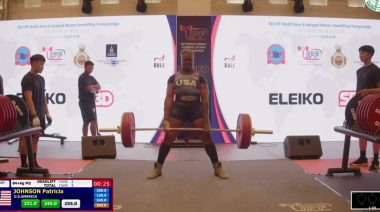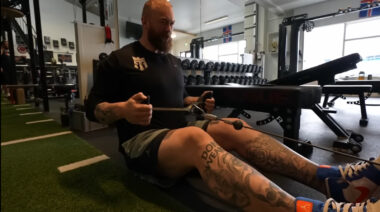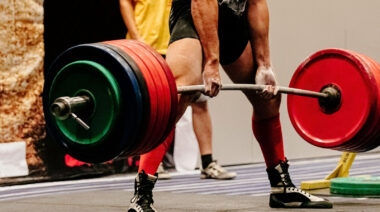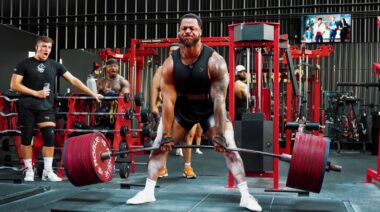With my last competition of the season in the books, it’s now time to reflect on this meet in order to improve before my next trip to the platform.
Looking Back
This was my first year powerlifting, and what a year it’s been. Looking back at my attempts from my first meet, it’s crazy to see how far along I’ve come. Technique was the most important aspect of training for me this year, and I’ve definitely accomplished that. Now that my form is good enough for three white lights, it’s time to throw on some serious weight.
RELATED: How I Got Started in Powerlifting
The easiest way for me to analyze this last meet is through a SWOT (strengths, weaknesses, opportunities, and threats) analysis. Call it a curse, but I was a business student, so this method is my bread and butter. For all intents and purposes, the SWOT analysis will lay out my strengths, weaknesses, opportunities, and threats from my last competition. The objective is to analyze these four pillars of training and set out a roadmap to accomplish my goals before my next meet.
Strengths
My laundry list of strengths from this meet include:
- Hitting personal records (PRs)
- Leaving injury free
- Making weight easily
- Using good technique
- Using effective training
- Having good training environment
I hit PRs because I programmed wisely leading up to the event, and I had good technique because I drilled technique every day at the gym. When it came to pausing the bench press on my chest and awaiting the “Press” command, I didn’t bat an eye. That’s because I trained for that pause every day.
“The objective is to analyze these four pillars of training and set out a roadmap to accomplish my goals before my next meet.”
I also believe I hit PRs because I hit a heavy training max every day, which gave me a ton of confidence under the bar. I was also able to easily get into the zone, as I do at my home gym day in and day out.
Weaknesses
Weaknesses are important to list to the minute detail, because these are the facets you can build upon. My biggest weaknesses of the meet were missing attempts, being undersized for my weight class, and simply not being strong enough. It’s forgivable to miss third attempts because sometimes your eyes are bigger than your muscles, and you just want to go for a fatty PR. Missing first attempts is unforgiveable.
So what went wrong? Did I choose an unwise opening attempt, or was I not training to proper depth every single day in the gym? Maybe I just had an off day or didn’t warm up enough. These are all things to evaluate.
“It’s forgivable to miss third attempts because sometimes your eyes are bigger than your muscles, and you just want to go for a fatty PR. Missing first attempts is unforgiveable.”
I was also undersized for my weight class, as I was the same size as most of the 148lb-ers (I’m 165lb). We’ll visit this later when I discuss opportunities. Finally, I wasn’t as strong as my competitors, which is easy to fix – get stronger. This was most likely due to my lack of experience, which is completely fine. Chasing numbers is a marathon, not a sprint. If I keep putting in the time and effort, I’ll get stronger.
READ: The Problem Is You: Time to Face Your Weaknesses
Opportunities
There’s always room for improvement, which leads us to opportunities. Next meet, I want to ensure I never miss a first attempt, so I will I program wisely during the tail end of my cycle in order to be fresh on meet day. I will also need to hit beyond proper depth on the squat every session in the gym, as I got dinged for missing depth. Big no-no. Lastly, I will work on picking out appropriate attempts and warming up properly. You don’t know how much my heart sank by missing the first lift to get into the meet. I’m just glad I didn’t bomb out.
RELATED: Powerlifting Meet Preparation: Practicing Commands
As far as being undersized, I will work on having a consistent diet. I’m pretty good with my diet, following the 80/20 rule, but you need precision for this sport. During my offseason and training cycle, I’ll need to fine tune my calories and micro/macronutrients to ensure I’m the best version of myself. I haven’t been as strict on my diet as I need to be. I’ll either need to cut some weight and fat to be in the 148lb class, or gain muscle and lose fat to be a big 165er. Everyone wants to be bigger and better, so I’ll probably default to the latter.
I also want to be stronger. The best way to do this is with consistent training. At this point I feel like getting the word consistent tattooed to myself, but you get the point. My numbers sky-rocketed over the past year, and that’s because I put in the work. Keep on keepin’ on! I will also need to work on more mobility drills, stretching, and yoga to guarantee my lower back is on the same page as the rest of my body.
RELATED: How to Stop Your Lower Back Pain
Threats
The threats level of this analysis would be anything that would keep me from performing to the best of my abilities between now and my next meet. My threats are injuries, scheduling, and accountability. I left injury free, which is always nice, but much to my chagrin, I tweaked my lower back per usual. In order to ensure I don’t get injured, maintaining proper form and exhausting all forms of recovery throughout my next cycle will be at the forefront of my training.
RELATED: Programming for Injury Prevention: How to Keep Your Athletes Healthy
My work schedule has been extremely hectic, and it’s oh-so-easy to feel fatigued and unmotivated after a long day in the office. This always leads to skipping the gym. Always. I have to be accountable. I have to plan around my work schedule, and ensure I hit every gym session and stay motivated. I chose to take this journey alone, and no one will know if I skip a training session. For this reason, I have to hold myself to a higher standard and be consistent with my training.
“Next meet, I want to ensure I never miss a first attempt, so I will make sure I program wisely during the tail end of my cycle in order to be fresh on meet day.”
Writing an athlete journal is also an amazing way to keep myself accountable. I don’t want to let anyone down!
Not really any meat or potatoes this week:
Monday – Sunday
Active Rest
That was it! I rested all week long. It was almost complete rest, but since I can’t stand not being in the gym, I went in for a few days of cardio. I rode bikes, used the rowing machine, played basketball, and went for some runs outside. I had to fight the urge to do anything with a dumbbell or barbell, but I was good.
READ: What Does Active Recovery Actually Mean?
I now know what worked and what didn’t work during my last meet and season. I know what I need to improve upon for my next season, and I will come back bigger, better, and stronger. Next week I’ll get back into the ol’ high frequency training. Thanks for reading, and stay active!
Ryan Seaver is a novice powerlifter who found his love for the sport after six years of going to the gym religiously. Follow Ryan’s journals to learn how to get started as a competitive lifter.






